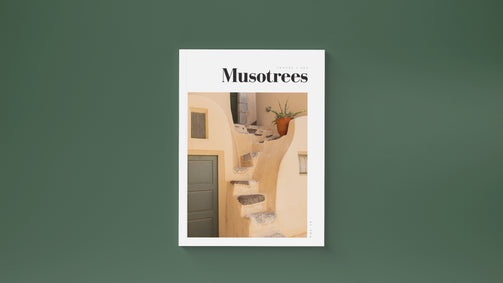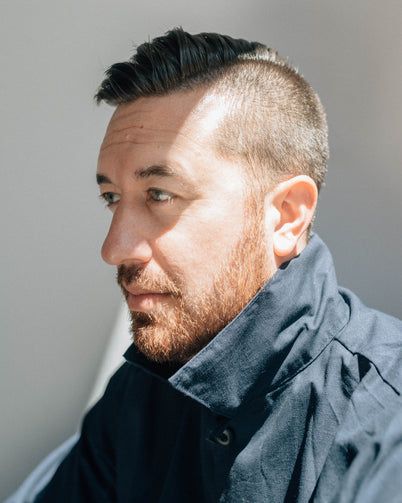EARLY BIRD DISCOUNT
The Muse Issue: Special Edition
[ 10% OFF ] Pre-order Volume 11

Volume Eleven
The Muse Issue
Special Edition
Summer 2024
INTRODUCING
Musotrees Volume 11: The Muse Issue
This special edition gathers stories of inspiration and encouragement from multiple cities in Portugal, Switzerland, Colombia, India, Malaysia, and the United Kingdom. For the first time, we are releasing a "dual magazine" in a single issue. Stay tuned for our full content reveal soon.
First Look \ Front Cover by Santiago Zapata.
*Early bird readers can pre-order today for a 10% discount worldwide. Shipment starts in August 2024. For Malaysians, free delivery is available for a limited time.
- Magazines 11 products
- Digital 7 products
- Living 28 products
- Limited 4 products
-
Musotrees Vol. 11 : Special Issue
- Regular price
- $20.00 USD
- Regular price
-
- Sale price
- $20.00 USD
- Unit price
- per
Sold Out- Regular price
- $20.00 USD
- Regular price
-
- Sale price
- $20.00 USD
- Unit price
- per
Sold Out -
Musotrees Vol. 10
- Regular price
- $17.00 USD
- Regular price
-
- Sale price
- $17.00 USD
- Unit price
- per
Sold Out- Regular price
- $17.00 USD
- Regular price
-
- Sale price
- $17.00 USD
- Unit price
- per
Sold Out -
Musotrees Vol. 9
- Regular price
- $17.00 USD
- Regular price
-
- Sale price
- $17.00 USD
- Unit price
- per
Sold Out- Regular price
- $17.00 USD
- Regular price
-
- Sale price
- $17.00 USD
- Unit price
- per
Sold Out -
Musotrees Vol. 8
- Regular price
- $17.00 USD
- Regular price
-
- Sale price
- $17.00 USD
- Unit price
- per
Sold Out- Regular price
- $17.00 USD
- Regular price
-
- Sale price
- $17.00 USD
- Unit price
- per
Sold Out -
Musotrees Vol. 7
- Regular price
- $17.00 USD
- Regular price
-
- Sale price
- $17.00 USD
- Unit price
- per
Sold Out- Regular price
- $17.00 USD
- Regular price
-
- Sale price
- $17.00 USD
- Unit price
- per
Sold Out -
Musotrees Vol. 6
- Regular price
- $17.00 USD
- Regular price
-
- Sale price
- $17.00 USD
- Unit price
- per
Sold Out- Regular price
- $17.00 USD
- Regular price
-
- Sale price
- $17.00 USD
- Unit price
- per
Sold Out
Showing 6 of 11 products on Magazines collection
-
Musotrees Vol. 7 - Digital
- Regular price
- $10.00 USD
- Regular price
-
$13.90 USD - Sale price
- $10.00 USD
- Unit price
- per
Sold Out- Regular price
- $10.00 USD
- Regular price
-
$13.90 USD - Sale price
- $10.00 USD
- Unit price
- per
Sold Out -
Musotrees Vol. 6 - Digital
- Regular price
- $10.00 USD
- Regular price
-
$12.50 USD - Sale price
- $10.00 USD
- Unit price
- per
Sold Out- Regular price
- $10.00 USD
- Regular price
-
$12.50 USD - Sale price
- $10.00 USD
- Unit price
- per
Sold Out -
Musotrees Vol. 5 - Digital
- Regular price
- $10.00 USD
- Regular price
-
$12.50 USD - Sale price
- $10.00 USD
- Unit price
- per
Sold Out- Regular price
- $10.00 USD
- Regular price
-
$12.50 USD - Sale price
- $10.00 USD
- Unit price
- per
Sold Out -
Musotrees Vol. 4 - Digital
- Regular price
- $8.00 USD
- Regular price
-
$11.90 USD - Sale price
- $8.00 USD
- Unit price
- per
Sold Out- Regular price
- $8.00 USD
- Regular price
-
$11.90 USD - Sale price
- $8.00 USD
- Unit price
- per
Sold Out -
Musotrees Vol. 3 - Digital
- Regular price
- $5.00 USD
- Regular price
-
$8.50 USD - Sale price
- $5.00 USD
- Unit price
- per
Sold Out- Regular price
- $5.00 USD
- Regular price
-
$8.50 USD - Sale price
- $5.00 USD
- Unit price
- per
Sold Out -
Musotrees Vol. 2 - Digital
- Regular price
- $5.00 USD
- Regular price
-
$8.50 USD - Sale price
- $5.00 USD
- Unit price
- per
Sold Out- Regular price
- $5.00 USD
- Regular price
-
$8.50 USD - Sale price
- $5.00 USD
- Unit price
- per
Sold Out
Showing 6 of 7 products on Digital collection
Living
-
Face Mask Musotrees: Red Fall
- Regular price
- $9.50 USD
- Regular price
-
- Sale price
- $9.50 USD
- Unit price
- per
Sold Out- Regular price
- $9.50 USD
- Regular price
-
- Sale price
- $9.50 USD
- Unit price
- per
Sold Out -
Face Mask Musotrees: Green Palm
- Regular price
- $9.50 USD
- Regular price
-
- Sale price
- $9.50 USD
- Unit price
- per
Sold Out- Regular price
- $9.50 USD
- Regular price
-
- Sale price
- $9.50 USD
- Unit price
- per
Sold Out -
Face Mask Musotrees: Blue Aztec
- Regular price
- $9.50 USD
- Regular price
-
- Sale price
- $9.50 USD
- Unit price
- per
Sold Out- Regular price
- $9.50 USD
- Regular price
-
- Sale price
- $9.50 USD
- Unit price
- per
Sold Out -
Face Mask Musotrees: Black Orange
- Regular price
- $9.50 USD
- Regular price
-
- Sale price
- $9.50 USD
- Unit price
- per
Sold Out- Regular price
- $9.50 USD
- Regular price
-
- Sale price
- $9.50 USD
- Unit price
- per
Sold Out -
Face Mask Musotrees: Off-White with Ties
- Regular price
- $6.80 USD
- Regular price
-
$8.50 USD - Sale price
- $6.80 USD
- Unit price
- per
Sold Out- Regular price
- $6.80 USD
- Regular price
-
$8.50 USD - Sale price
- $6.80 USD
- Unit price
- per
Sold Out -
Face Mask Musotrees: Black Everyday
- Regular price
- $47.60 USD
- Regular price
-
$59.50 USD - Sale price
- $47.60 USD
- Unit price
- per
Sold Out- Regular price
- $47.60 USD
- Regular price
-
$59.50 USD - Sale price
- $47.60 USD
- Unit price
- per
Sold Out
Showing 6 of 28 products on Living collection
-
Musotrees Buku 555 – Perak Bundle
- Regular price
- $7.50 USD
- Regular price
-
- Sale price
- $7.50 USD
- Unit price
- per
Sold Out- Regular price
- $7.50 USD
- Regular price
-
- Sale price
- $7.50 USD
- Unit price
- per
Sold Out -
Musotrees Buku 555 – Terengganu Bundle
- Regular price
- $7.50 USD
- Regular price
-
- Sale price
- $7.50 USD
- Unit price
- per
Sold Out- Regular price
- $7.50 USD
- Regular price
-
- Sale price
- $7.50 USD
- Unit price
- per
Sold Out -
Musotrees - Batik sleeves with Nysakapas
- Regular price
- $0.00 USD
- Regular price
-
- Sale price
- $0.00 USD
- Unit price
- per
Sold Out- Regular price
- $0.00 USD
- Regular price
-
- Sale price
- $0.00 USD
- Unit price
- per
Sold Out -
Musotrees Travel Planner by ana tomy
- Regular price
- $14.00 USD
- Regular price
-
- Sale price
- $14.00 USD
- Unit price
- per
Sold Out- Regular price
- $14.00 USD
- Regular price
-
- Sale price
- $14.00 USD
- Unit price
- per
Sold Out
FRONT COVER : SANTORINI, GREECE.
A
MELANCHOLIC
LONGING
FOR SANTORINI.
Story by Macarena Armario
"In these times, when everything is moving so fast and we live in a world of constant immediacy, stopping to see, reflect and feel with a photograph is almost a revolution ."
"All these connections made through the sensations experienced created a symbiotic bond between the person and the place, which lasts forever."
/


LAUNCHING EVENT

INTERVIEW HIGHLIGHT / THE DEPARTURE ISSUE : BALI & SYDNEY



A Conversation with Nicholas Vodicka, Co-Founder Softer Volumes.
Interview by Kerol Izwan
I remember meeting Nicholas at a cafe nearby his office, located in a docile neighbourhood not far from Sydney. After a laid-back conversation, he gave me a tour of his office, where we continued talking about his design preferences and aesthetics. At that time, Nicholas was running a magazine called Hey Gents, a handsome guide magazine for gentlemen.
/

I asked, "Here's the million-dollar question: Why the name Softer Volumes? Enlighten us."
/
STORY HIGHLIGHT / THE DEPARTURE ISSUE : POKHARA, NEPAL
Hemja Camp Pokhara:
Story by Rayna Carruthers
A Legacy At A Crossroads


"From the day Norchung was born, he was destined to be a monk – In 1959 at 23 years age, Norchung was forced to flee his monastery in Tibet to Mustang."
/
INTERVIEW HIGHLIGHT / THE DEPARTURE ISSUE : SÃO PAULO, BRAZIL.
Raphael Dias & Raffaele Asselta
A Conversation with Casa Diaria's Brazilian Duo.


Interview By Kerol Izwan
I was genuinely interested in Casa Diaria growth, especially how they pivoted during the pandemic. Raphael and Raffaele have created sublime tapestries and various artworks, which are now exhibited at the store. On top of that, this dynamic duo have branched out into diverse things, including curating a gallery of their own creations and organising soulful events to connect with creatives in the city.
WHAT'S NEW IN THIS ISSUE?
Created in Malaysia with lenses

from all over the world.
PAST ISSUE : VOLUME 9
Snapshots of Serendipity.
My venture into photography, which took a serious turn during the pandemic, yields interesting perspectives.










































